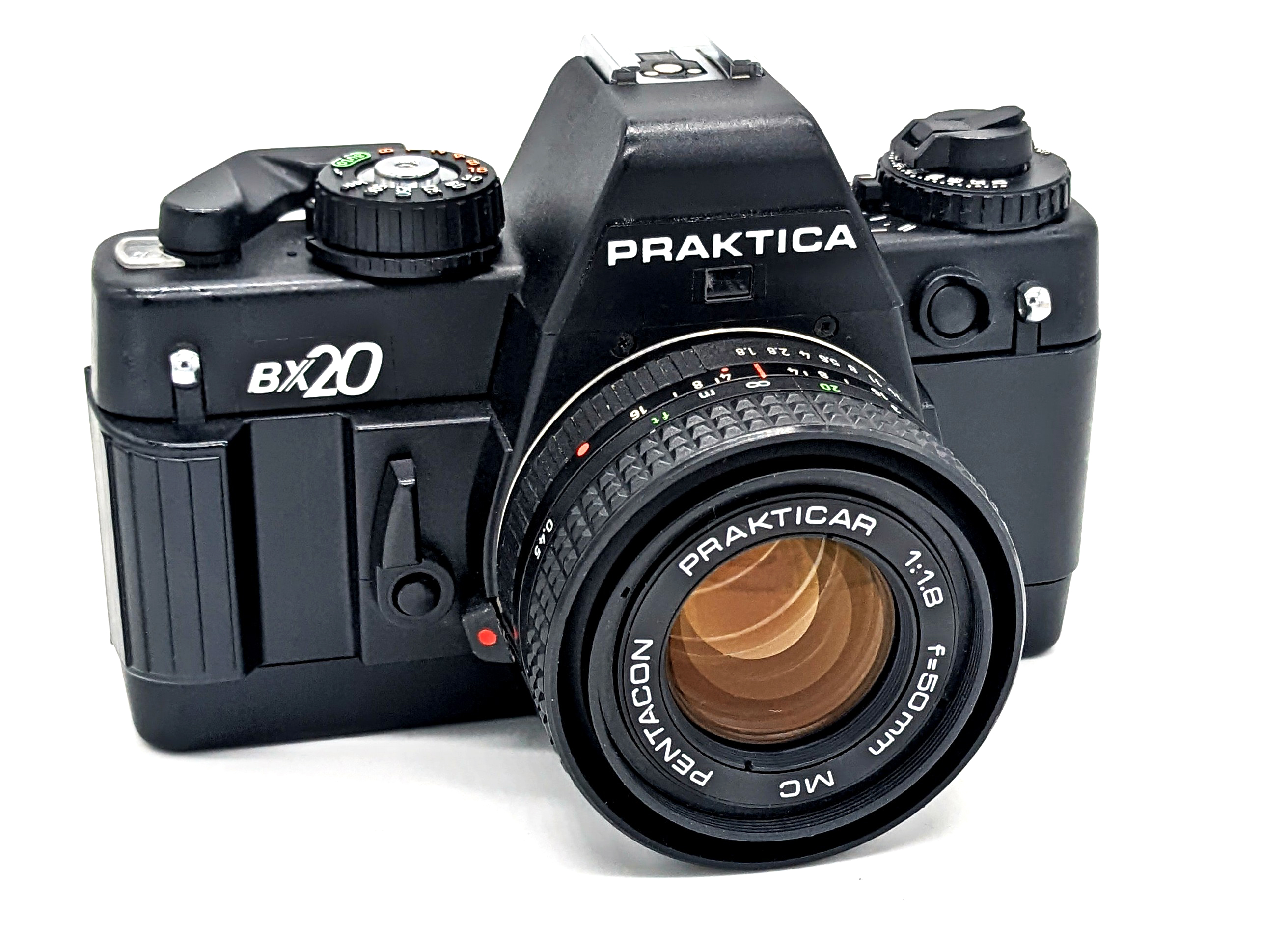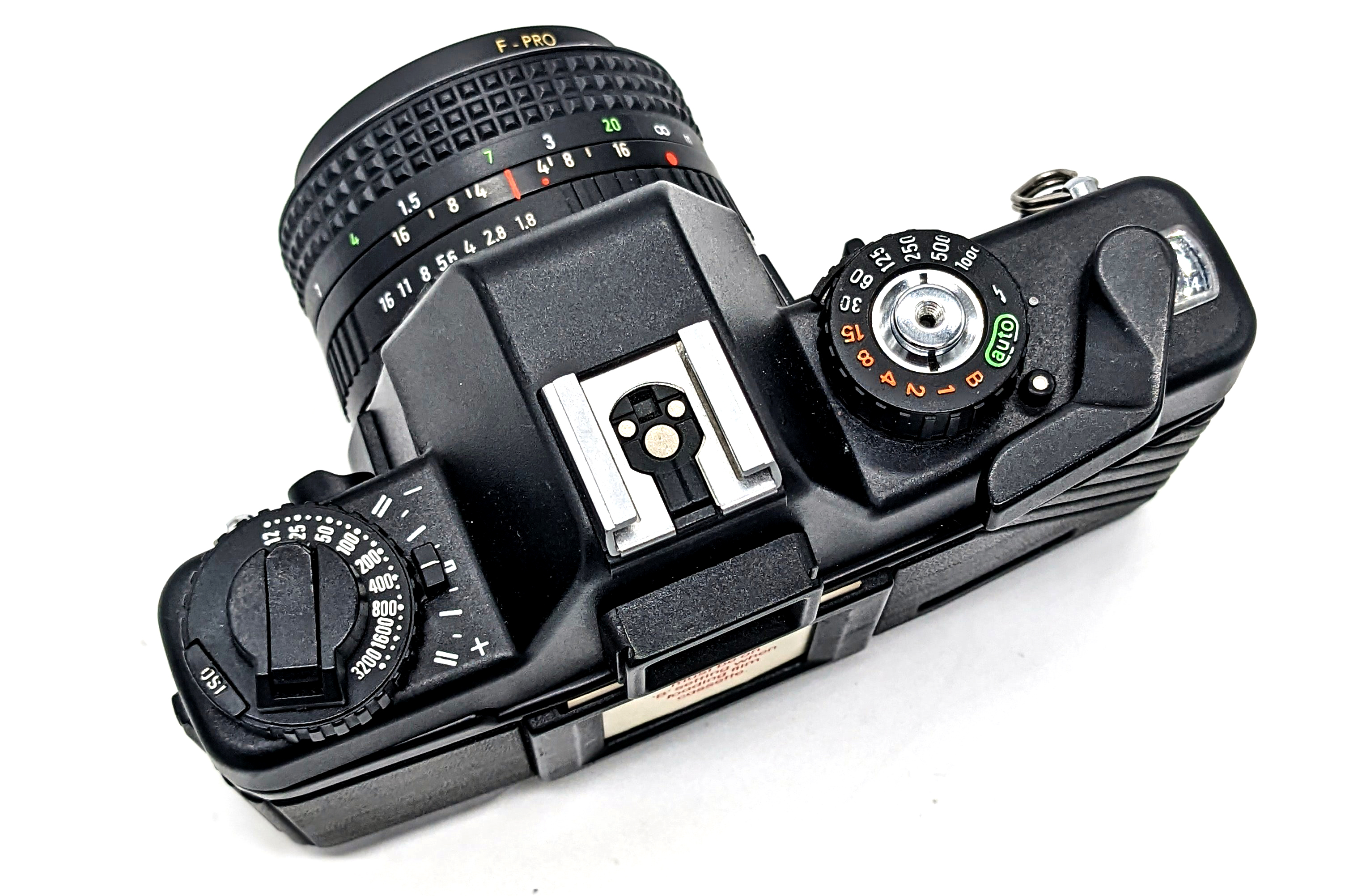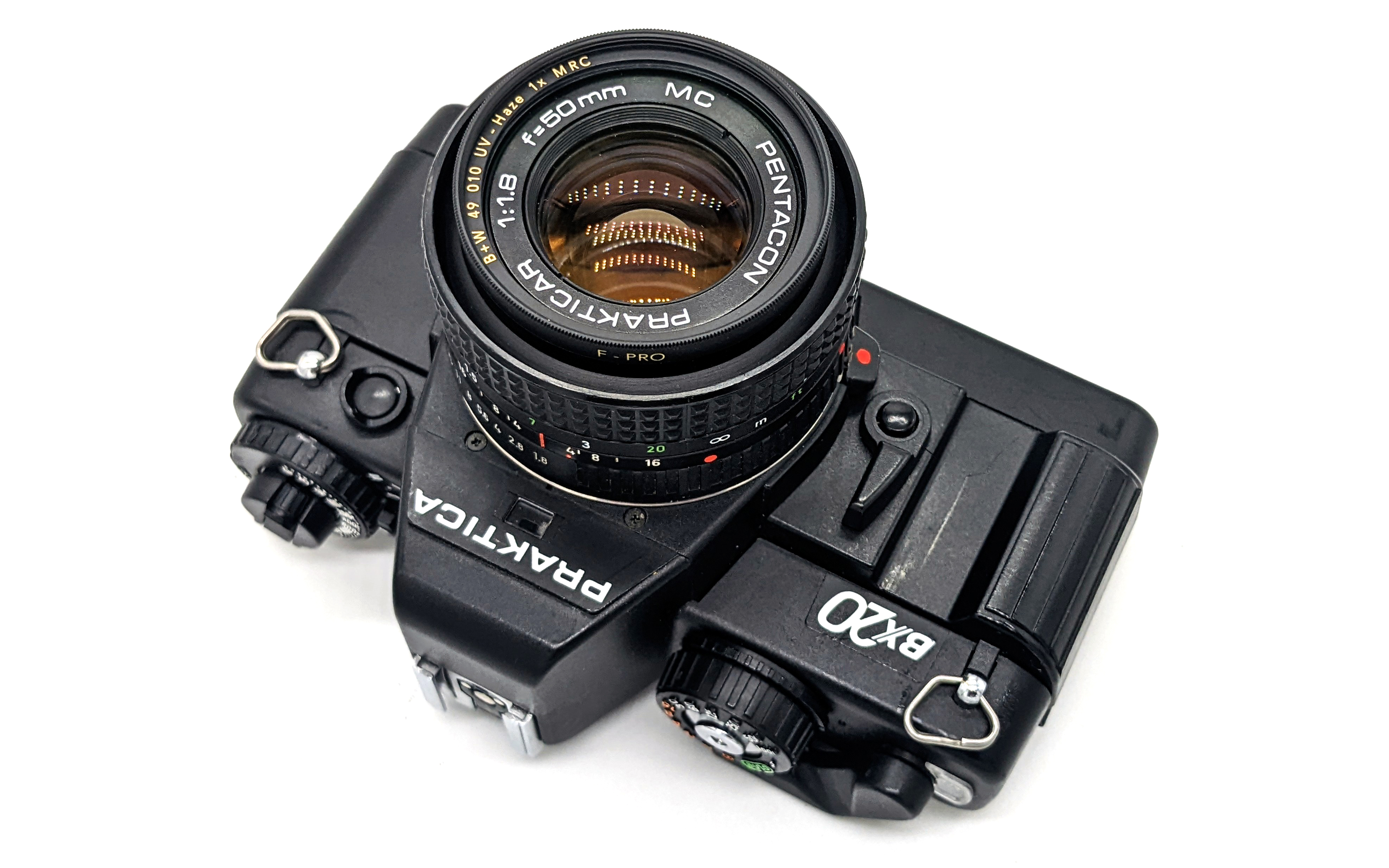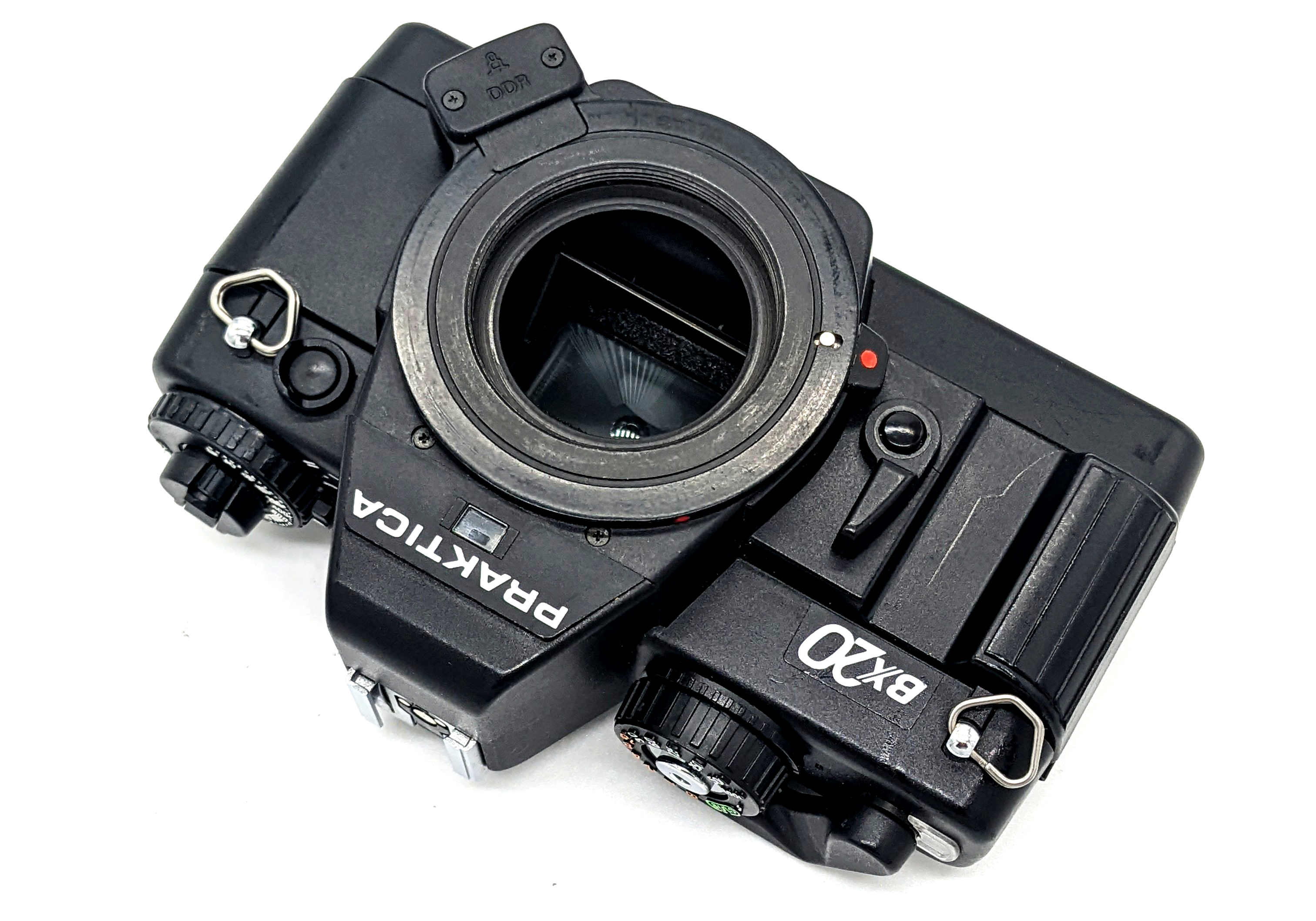
The 1987 East German Praktica BX20 was the penultimate model in Pentacon’s “PB” line of cameras. A departure from the design of Praktica’s prior 1979 B200 and 1984 BC-1, the plastic-shelled BX20 incorporates everything interesting about PB cameras while adding the capability for TTL flash. With a great selection of lenses by Carl Zeiss Jena and Pentacon, the BX20 is a nice little camera, although a little inelegant and clunky.
In line with prior moves from Pentax, Fujica, Yashica, and others, Pentacon dropped the M42 lens mount for its Praktica-branded cameras in 1979 and adopted a new bayonet mount. Praktica’s final “new” M42 camera bodies, the 1977 EE2 and the short-lived 1979 EE3, were interesting autoexposure models with decent capabilities, but far from perfect. Praktica did not completely abandon the M42 standard in 1979 as it continued to produce the outdated third-generation MT series until about 1989.
Praktica’s first bayonet camera model, the 1979 B200, adopted not only a new lens mount but also employed a stepless electronic shutter, capable of aperture-priority autoexposure. During the 1980s, Praktica produced both a higher-end and lower-end models in this mount. The B200 (1979), also known as the BC-X (export version), the BC-1 (1984), also known as the BC-3 and Jenaflex AM-1 (export versions), and the BX20 (1987) were the “higher end” models. The “lower end,” de-featured models included the B100, BCA, BCS, BCC, BMS, and Jenaflex AC-1. For the best source of information of essentially all Praktica camera bodies, check out this famous site.
For its part, the B200 was a competitive advanced amateur SLR body for 1979, the era of the Nikon FM, the Canon A-1, and the Pentax ME. During the run of the B200, its lens lineup contained a mix of: (1) more expensive Carl Zeiss Jena lenses; (2) “reasonably”-priced Pentacon-branded ones; and (3) a few aftermarket, mostly-zoom lenses made in Japan. Although the SLR camera market was becoming increasingly competitive, Praktica’s 1984 BC-1 (essentially, a slightly-redesigned B200) did not move the ball forward.
Pentacon’s 1987 Praktica BX20 included a complete body redesign, a slightly faster flash sync speed, the capability for TTL flash (using the same system as Olympus), and a relocated exposure lock button. During its run, the BX20 was typically bundled with the final version of the Pentacon-made 50mm f/1.8 Prakticar lens, reportedly based on the earlier Meyer Optik 50mm f/1.8 Orestor. Around the time of German reunification, the government formally dissolved Pentacon. In 1991, Schneider Kreuznach acquired much of Pentacon’s camera assets and continued the production of a final model, the Praktica BX20s, until about 2001. The BX20s included another slight body redesign and the incorporation of DX film coding.
That all being said, more than 35 years after its introduction, is the BX20 a worthwhile platform? Part of the appeal of these late Prakticas is that while they are plentiful and relatively cheap in Europe and other markets, the B/BX series was pretty much unknown in North America. Compared with any run-of-the-mill 1970s M42 camera body, the B and BX bodies have generally brighter viewfinders, aperture-priority autoexposure, exposure lock, and TTL flash capability. If you enjoy using late-model multicoated Carl Zeiss Jena SLR lenses, the Praktica B series is arguably a better platform for these lenses than any classic M42 body. The B-series can also employ some CZJ lenses that were either extremely rare or never existed in M42 mount, like the 55mm f/2.8 Macro (no M42 version), both versions of the 50mm f/1.4 (no M42 version), and the 35-70mm f/2.7-3.5 zoom (rare and expensive in M42 mount).
Specifications for the Higher-End Praktica B Camera
There is not much that distinguishes the higher-end Praktica B camera bodies from each other in terms of functionality. They all seem to use the same shutter, focusing screen, viewfinder design, and metering system. Here the are features compared:
| B200 | BC-1 | BX20 | BX20s | |
| Year | 1979 | 1984 | 1987 | 1992 |
| Manufacturer | Pentacon | Pentacon | Pentacon | Schneider |
| Shutter | Vertical Metal | Vertical Metal | Vertical Metal | Vertical Metal |
| Shutter Speeds | B, 40 sec – 1/1000 | B, 40 sec – 1/1000 | B, 40 sec – 1/1000 | B, 40 sec – 1/1000 |
| Battery | PX28 | PX28 | PX28 | PX28 |
| Weight | 530g | 530g | 510g | 510g |
| ASA | 12-3200 | 12-3200 | 12-3200 | 25-5000 (DX); 25-400 (Manual) |
| Meter | Center | Center | Center | Center |
| VF Coverage | 95% | 95% | 95% | 95% |
| Focusing Screen | Wedge / Microprism / Ground Glass | Wedge / Microprism / Ground Glass | Wedge / Microprism / Ground Glass | Wedge / Microprism / Ground Glass |
| Flash Sync | 1/90 | 1/90 | 1/100 | 1/100 |
| Shutter Speed / Aperture in VF? | Yes | Yes | Yes | Yes |
| TTL Flash? | No | No | Yes | Yes |
| AE Lock? | Button on Top | Button on Top | Button in Front | Button in Front |
| Motor Drive Capable? | Yes | Yes | Yes | Yes |
| DX Coding? | No | No | No | Yes |

Praktica B Lenses
Perhaps the primary reason to acquire a Praktica B camera is for the use of the several pretty good lenses that were made for the system. For a great and exhaustive resource on the Praktica line of PB-mount lenses, check out this site. While most of the system’s prime lenses were sourced by Pentacon either in-house or using third-party East German designs, CZJ either designed (or at least put its name on) other lenses, including some carryovers from the M42 era. Here is a list of the East German-designed lenses for the system.

| Brand | Focal Length | Elements/Groups | Min. Focus | Filter Size | Notes |
| CZJ | 20mm f/2.8 | 9/8 | 0.19m | 67mm | M42 Carryover |
| CZJ | 28mm f/2.4 | 8/8 | 0.19m | 49mm | Floating Element; Extremely Rare |
| CZJ | 35mm f/2.4 | 6/6 | 0.22m | 49mm | M42 Carryover |
| CZJ | 50mm f/1.4 V1 | 7/6 | 0.36m | 52mm | Based on M42 55mm f/1.4 |
| CZJ | 50mm f/1.4 V2 | 7/6 | 0.40m | 52mm | Better Version |
| CZJ | 50mm f/1.8 | 6/5 | 0.35m | 49mm | M42 Carryover |
| CZJ | 50mm f/2.8 | 4/3 | 0.35m | 49mm | M42 Carryover; Very Rare |
| CZJ | 55mm f/2.8 | 6/5 | 0.25mm | 49mm | 1:2 Macro; Rare |
| CZJ | 80mm f/1.8 | 6/5 | 0.65m | 52mm | M42 Carryover |
| CZJ | 135mm f/3.5 | 4/3 | 49mm | M42 Carryover | |
| CZJ | 200mm f/2.8 | 6/5 | 2.00m | New Design | |
| CZJ | 300mm f/4 | 6/5 | 4.00m | New Design | |
| CZJ | 35-70mm f/2.7-3.5 | 9/8 | M42 Carryover | ||
| CZJ | 80-200mm f/4 | 12/6 | 1.10m | M42 Carryover | |
| Pentacon | 28mm f/2.8 | 7/7 | 0.25m | 49mm | East German Design |
| Pentacon | 50mm f/1.8 V1 | 6/4 | 0.33m | 49mm | Earlier Kit Lens |
| Pentacon | 50mm f/1.8 V2 | 6/4 | 0.45m | 49mm | Later Kit Lens |
| Pentacon | 50mm f/2.4 | 5/4 | 0.60m | 49mm | Two Versions (Metal / Plastic) |
| Pentacon | 135mm f/2.8 | 5/4 | 1.70m | 55mm | Orestor Design |

The winners in this list mostly include all of the CZJ lenses. The Pentacon lenses can be pretty decent performers, but they are really nothing special for the 1980s.

Features
The BX20 presents the standard set of features found on many late-1970s to mid-1980s advanced-amateur SLRs. Its plastic body does not feel particularly cheap and is pretty comfortable in the hands.
Battery: The PX28 was originally a 6V mercury battery. While PX28s are no longer available, there are both silver oxide (S28PX) and alkaline (A544) replacements widely available. Lithium 6V substitutes do not seem to work.
Viewfinder/Focusing Screen: The BX20 has a relatively nice and bright viewfinder that displays in LED the shutter speed, the selected aperture (for PB lenses), an +/- indicator on the left that tells you if the exposure compensation is activated or manual ASA is set, and a green light to remind you whether the exposure lock has been activated. The PB series all share a nice and useful focusing screen with a dual 45 degree split-image, a microprism collar, and a ground glass.
Shutter Speeds: A 1/1000 top shutter speed is definitely below average for 1987. The shutter sound is a a bit metallic but not unpleasing.
Exposure Lock: The BX20 relocated the exposure lock button from the top to the front of the camera. To use this, half-depress the shutter to take a reading of the desired subject, press the button while still half-depressing the shutter, and then shoot. If you take your finger off the shutter release at any point, the AEL stops working. The system is a little finicky as I had a beautiful condition BX20s whose AEL did not work at all. My example of the BX20 sometimes takes more than one press to get the AEL mode to function.

Adapting M42 Lenses
Pentacon did not leave its legacy M42 users completely high and dry and produced an OEM adapter permitting autoexposure with “stopped down” metering, which means that an M42 lens must be closed down to taking aperture (thus, darkening the viewfinder) for the camera to meter. This is pretty much how all modern M42 to whatever adapters work. However, the adapter required an electrical connection to the camera body because the light meter will not function unless those contacts are made. As far as I know, there are no other third-party M42 to Praktica B adapters apart from the OEM one.
Accessories
Leather Case: Praktica produced a universal ever-ready case for the B and BX series.
Motor Drive: For the B and BX series, Praktica produced three unremarkable external power winders with three separate names: the “Winder,” the “B Winder,” and the “BX Winder.” The first two were allegedly made in Japan while the BX Winder was made in Germany. The BX Winder apparently promised 3 frames per second. All three winders are incredibly loud and take AA batteries.
TTL Flashes: Because Praktica BX cameras share TTL technology with the Olympus OM series, there are a wide variety of TTL flashes that can be used. The actual Praktica-branded TTL flashes include the basic BD-24, the more advanced LCD-style BD-32 (produced by Samyang), and a simpler BD-36 (produced by Samyang). The BX series can also use Metz TTL flashes with the SCA321 module.
Conclusion
Folks often say that forbidden fruit often tastes the best. While Praktica B/BX camera bodies were relatively popular in Europe (being a good value, German-designed camera), they never really reached North America when sold as new. With its standard Pentacon 50mm f/1.8 lens or with any of the mediocre zooms offered for the system, the case for the BX series over plenty of other options becomes pretty weak. While the BX bodies are not really spec-competitive with most popular SLRs made after 1985 or so, they remain the only film platform for some world-class CZJ lenses. While some have reported electronics failures with the BX series over the years, there are still plenty of working models out there. With the primary source of used BX cameras still being Europe, they are nevertheless purchasable any day through the normal internet channels.